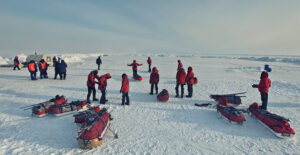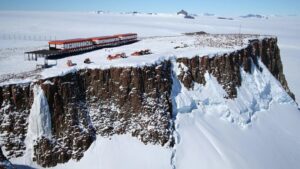Although I’ve done many expeditions to both the North and South Poles, both as an independent traveler and a guide, every fresh trip brings up new gear ideas. There are also old, tried-and-true standards that I have used for years. As I begin the South Pole season, let’s take a look at my gear, starting with how I protect my face on the Antarctic plateau.
One note: Proper gear is just one aspect of polar travel. Developing skills, planning and logistics, understanding the polar environment, and knowing how to minimize risk are all equally important. If you would like to fast-track your development as a polar traveler, consider hiring an IPGA Polar Expedition Guide.
Setup one: severe cold

Consider this for deep cold and high winds, where any exposed skin becomes frostbitten and layers can be penetrated. The full sunburst fur ruff, formed by closing the tilt-able hood and storm collar on my shell jacket, disrupts wind and creates a microclimate around my face. It adds a final protective layer above my Julbo Aerospace goggles, Celsius Hat, and Guru Face Mask.
Not one iota of skin is exposed. Any colder and it’s not wise to be outside. I’ve rarely needed this kind of protection: only on the Arctic Ocean and Antarctic plateau when conditions are truly bitter.
Setup two: manageable wind

This works when wind and cold are more manageable wind but will still frostbite exposed skin.
My Julbo goggles mesh perfectly with my Icetrek Celius Hat and Guru Face Mask to create an impervious barrier. Again, no exposed skin. People often place tape on their cheeks but no need if you have the right rig.
It’s important for the mask to be open at the bottom, allowing the exhaled breath to escape. Otherwise, it moves up into the eyewear which, if poorly designed, can freeze onto the inside of the lens. Julbo Aerospace goggles deal with this perfectly, having a hinged lens that pulls away from the frame, creating airflow.
My wolf/wolverine ruff still provides a warm pillow of air around my face, despite venting with the open storm collar of my Mont polar jacket. Still bloody cold but I can tolerate a full day of this.
Setup three: no hood

I’m still fully protected but no longer require my hood or ruff, a common strategy on the Antarctic plateau.
My Celsius Hat is made of eVent windproof fleece, and the ear flaps give my lobes full protection. My Guru face mask is made from hypoallergenic neoprene, high cut to protect the upper cheeks, full nose protection, and just the right amount of breathing holes. A neck gaiter protects the exposed area below my mask.
I’ll flip my hood up and down as conditions dictate, but all my venting adjustments are done on the fly, so long as I’ve made the right wardrobe choices when I get dressed in the morning.
Setup four: exposed skin

Philips skis the Ross Ice Shelf to the South Pole via the Reedy Glacier, 2016. Photo: Eric Philips
Exposed skin can now tolerate the conditions, but only when I’m working hard enough to generate heat.
I’ve exchanged my thick fleece hat for a thinner windproof cap with a small peak. Direct sun glare is not an issue on a South Pole expedition because I structure a travel schedule that has the sun behind me. This is easier on the eyes, eliminates the need for a big peak, and lets me use my shadow to navigate. I swap my goggles for Julbo Ultimate Cover sunglasses. The Guru mask is still doing its thing.
Setup five: getting warmer

The cap and mask are exchanged for a breathable Icetrek LoGo Beanie and Smitten merino neck gaiter, pulled over my nose if needed.
I still need to be careful with exposed skin, in particular my earlobes, but the beanie is long and can pull down to fully protect my ears if required. Don’t take the fashionable beanie that sits halfway down your ears. Leave that for the ski slopes.
I’ve attached a nose guard to my Julbo glasses, for both sun and wind protection.
Setup six: as warm as it gets

Rarely do we experience warm days on the Antarctic plateau. Those are much more typical of lower elevations. I struggle when it gets this warm. Gone is the shell jacket. I now travel in my superlight Smitten merino beanie, Julbo Ultimate Cover glasses, buff, and Mont Grid Pro fleece, which is a superb, all-around zippered top. Lots of sunscreen and lip balm.






